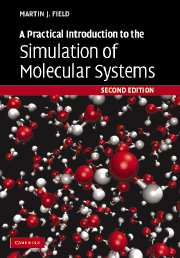Book contents
- Frontmatter
- Contents
- Preface to the first edition
- Preface to the second edition
- 1 Preliminaries
- 2 Chemical models and representations
- 3 Coordinates and coordinate manipulations
- 4 Quantum chemical models
- 5 Molecular mechanics
- 6 Hybrid potentials
- 7 Finding stationary points and reaction paths on potential energy surfaces
- 8 Normal mode analysis
- 9 Molecular dynamics simulations I
- 10 More on non-bonding interactions
- 11 Molecular dynamics simulations II
- 12 Monte Carlo simulations
- Appendix 1 The pDynamo library
- Appendix 2 Mathematical appendix
- Appendix 3 Solvent boxes and solvated molecules
- Bibliography
- Author index
- Subject index
Preface to the second edition
Published online by Cambridge University Press: 03 December 2009
- Frontmatter
- Contents
- Preface to the first edition
- Preface to the second edition
- 1 Preliminaries
- 2 Chemical models and representations
- 3 Coordinates and coordinate manipulations
- 4 Quantum chemical models
- 5 Molecular mechanics
- 6 Hybrid potentials
- 7 Finding stationary points and reaction paths on potential energy surfaces
- 8 Normal mode analysis
- 9 Molecular dynamics simulations I
- 10 More on non-bonding interactions
- 11 Molecular dynamics simulations II
- 12 Monte Carlo simulations
- Appendix 1 The pDynamo library
- Appendix 2 Mathematical appendix
- Appendix 3 Solvent boxes and solvated molecules
- Bibliography
- Author index
- Subject index
Summary
This edition of A Practical Introduction has two major differences from the previous one. The first is a discussion of quantum chemical and hybrid potential methods for calculating the potential energies of molecular systems. Quantum chemical approaches are more costly than molecular mechanical techniques but are, in principle, more ‘exact’ and greatly extend the types of phenomena that can be studied with the other algorithms described in the book. The second difference is the replacement of fortran 90 by Python as the language in which the dynamo module library and the book's computer programs are written. This change was aimed to make the library more accessible and easier to use. As well as these major changes, there have been many minor modifications, some of which I wanted to make myself but many that were inspired by the suggestions of readers of the first edition.
Once again, I would like to acknowledge my collaborators at the Institut de Biologie Structurale in Grenoble and elsewhere for their comments and feedback. Special thanks go to all members, past and present, of the Laboratoire de Dynamique Moléculaire at the IBS, to Konrad Hinsen at the Centre de Biophysique Moléculaire in Orléans and to Troy Wymore at the Pittsburgh Supercomputing Center. I would also like to thank Michelle Carey, Anna Littlewood and the staff of Cambridge University Press for their help during the preparation of this edition, Johny Sebastian from TechBooks for answers to my many LATEX questions, and, of course, my family for their support.
- Type
- Chapter
- Information
- Publisher: Cambridge University PressPrint publication year: 2007



